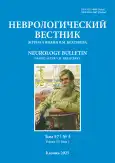Судебно-психиатрическое значение общественно опасных действий, направленных на своих детей, у женщин, больных шизофренией
- Авторы: Шпорт С.В.1, Хамитов Р.Р.2,3, Афзалетдинова Д.Х.4,5, Качаева М.А.1,6, Скибина Н.В.1,6, Назарова Л.Н.6
-
Учреждения:
- Национальный медицинский исследовательский центр психиатрии и наркологии им. В.П. Сербского
- Казанская психиатрическая больница (стационар) специализированного типа с интенсивным наблюдением
- Казанский государственный медицинской университет
- Башкирский государственный медицинский университет
- Республиканская клиническая психиатрическая больница, Уфа
- Первый Московский государственный медицинский университет им. И.М. Сеченова (Сеченовский Университет)
- Выпуск: Том LVII, № 3 (2025)
- Страницы: 237-246
- Раздел: Оригинальные исследования
- URL: https://journal-vniispk.ru/1027-4898/article/view/349009
- DOI: https://doi.org/10.17816/nb669182
- EDN: https://elibrary.ru/KOXEDQ
- ID: 349009
Цитировать
Аннотация
Обоснование. Исследование факторов риска совершения агрессивно-насильственных действий в отношении своих детей женщинами, больными шизофренией, по-прежнему является актуальным, поскольку взаимосвязь психопатологических синдромов и социально-психологических факторов остаётся недостаточно изученной.
Цель. Выявление психопатологических и социальных факторов, способствующих совершению убийства своих детей, женщинами, страдающими шизофренией.
Методы. Дизайн: мультицентровое описательное ретроспективное сравнительное исследование медицинских карт и заключений судебно-психиатрических экспертиз без непосредственного участия пациенток. Критерии включения в основную группу: женский пол, диагноз «шизофрения», совершённое убийство ребёнка (детей) в 2016–2023 гг., решение суда о признании пациентки невменяемой. Период проведения исследования — май–сентябрь 2024 г. Методы оценки: клинико-психопатологический, клинико-катамнестический, статистический.
Результаты. Выделены 3 группы: 1-я (основная, n=28) — пациентки, совершившие убийство своего ребёнка, 2-я (сопоставления, n=34) — пациентки, совершившие убийство вне семьи (знакомых, случайных лиц старше 18 лет), 3-я (контрольная, n=56) — пациентки, ранее не совершавшие правонарушений. Результат сравнения 1-й и 2-й групп обозначен как р1, 1-й и 3-й групп — р2, 2-й и 3-й групп — р3. Сравнительный анализ показал, что достоверно чаще убийство ребёнка было совершено в дебюте шизофрении (р1=0,001), к моменту совершения правонарушения пациентки часто не наблюдались у психиатра (р1=0,026). Преобладающим являлся продуктивно-психотический механизм совершения правонарушения (р1=0,001), выявлены особенности бреда в сочетании с альтруистическим мотивом. Среди личностных особенностей преобладали склонность к защите, обидчивость, впечатлительность (р1=0,001).
Заключение. Анализ показал преобладание психопатологических синдромов при совершении детоубийств и бóльшую значимость социальных факторов при агрессивно-насильственных действиях, совершённых вне семьи. Выявленные предикторы будут способствовать профилактике общественно опасных действий у женщин, больных шизофренией.
Ключевые слова
Полный текст
Открыть статью на сайте журналаОб авторах
Светлана Вячеславовна Шпорт
Национальный медицинский исследовательский центр психиатрии и наркологии им. В.П. Сербского
Email: svshport@mail.ru
ORCID iD: 0000-0003-0739-4121
SPIN-код: 2926-9305
д-р мед. наук
Россия, МоскваРустем Радикович Хамитов
Казанская психиатрическая больница (стационар) специализированного типа с интенсивным наблюдением; Казанский государственный медицинской университет
Email: rrkzn@mail.ru
ORCID iD: 0000-0002-1271-8330
SPIN-код: 4923-9370
д-р мед. наук, профессор
Россия, Казань; КазаньДинара Хасановна Афзалетдинова
Башкирский государственный медицинский университет; Республиканская клиническая психиатрическая больница, Уфа
Автор, ответственный за переписку.
Email: dinara-05@list.ru
ORCID iD: 0000-0003-1042-3528
SPIN-код: 4090-3272
канд. мед. наук
Россия, Уфа; УфаМаргарита Александровна Качаева
Национальный медицинский исследовательский центр психиатрии и наркологии им. В.П. Сербского; Первый Московский государственный медицинский университет им. И.М. Сеченова (Сеченовский Университет)
Email: mkachaeva@mail.ru
ORCID iD: 0000-0002-7642-9829
SPIN-код: 4565-1293
д-р мед. наук, профессор
Россия, Москва; МоскваНадежда Владимировна Скибина
Национальный медицинский исследовательский центр психиатрии и наркологии им. В.П. Сербского; Первый Московский государственный медицинский университет им. И.М. Сеченова (Сеченовский Университет)
Email: nskibina59@mail.ru
ORCID iD: 0000-0003-4721-3962
SPIN-код: 6215-1636
канд. мед. наук, доцент
Россия, Москва; МоскваЛионелла Николаевна Назарова
Первый Московский государственный медицинский университет им. И.М. Сеченова (Сеченовский Университет)
Email: LnLn2016@bk.ru
ORCID iD: 0000-0003-1991-0920
SPIN-код: 5926-0863
канд. мед. наук, доцент
Россия, МоскваСписок литературы
- Klier CM, Fisher J, Chandra PS, Spinelli M. Filicide research in the twenty-first century. Arch Womens Ment Health. 2019;22(1):135–137. doi: 10.1007/s00737-018-0924-0
- Mugavin M. Maternal filicide theoretical framework. J Forensic Nurs. 2008;4(2):68–79. doi: 10.1111/j.1939-3938.2008.00012.x
- Dmitrieva TB, Immerman KL, Kachaeva MA, Romasenko LV. Criminal aggression of women with mental disorders. Moscow: Medicina; 2003. 246 р. (In Russ.) ISBN: 5-225-04311-9
- Kachaeva MA, Kharitonova NK, Vasyanina VI, et al. Mental disorders in women victims of domestic violence. A case of child murder (extended suicide). In: Fastovtsov GA, editor. The practice of forensic psychiatric examination: Collection No. 61. Moscow: NMICzPN im. V.P. Serbskogo; 2023. Р. 100–108. (In Russ.) EDN: CYEGLB
- McCarroll JE, Fisher JE, Cozza SJ, et al. Characteristics, classification, and prevention of child maltreatment fatalities. Mil Med. 2017;182(1):e1551–e1557. doi: 10.7205/MILMED-D-16-00039
- Lattanzi GM, Provini L, Williams R, et al. Personality structure and attachment models of women who kill their children. A systematic review on maternal filicide. Child Abuse Negl. 2020;106:104532. doi: 10.1016/j.chiabu.2020.104532
- Friedman SH, Horwitz SM, Resnick PJ. Child murder by mothers: a critical analysis of the current state of knowledge and a research agenda. Am J Psychiatry. 2005;162(9):1578–1587. doi: 10.1176/appi.ajp.162.9.1578
- Putkonen H, Amon S, Weizmann-Henelius G, et al. Classifying Filicide. International Journal of Forensic Mental Health. 2016;15(2):1–13. doi: 10.1080/14999013.2016.1152616
- Brown T, Bricknell S, Bryant W, et al. Filicide offenders. Trends and Issues in Crime and Criminal Justice. 2019;(568):1–17.
- Ospanova AV, Kachaeva MA, Kharitonova NK, et al. The case of child abuse by a woman with schizophrenia. Delegated Munchausen proxy syndrome. In: Fastovtsov GA, editor. The practice of forensic psychiatric examination: Collection No. 58. Moscow: NMICzPN im. V.P. Serbskogo; 2020. Р. 28–40. (In Russ.) EDN: XVFNME
Дополнительные файлы





